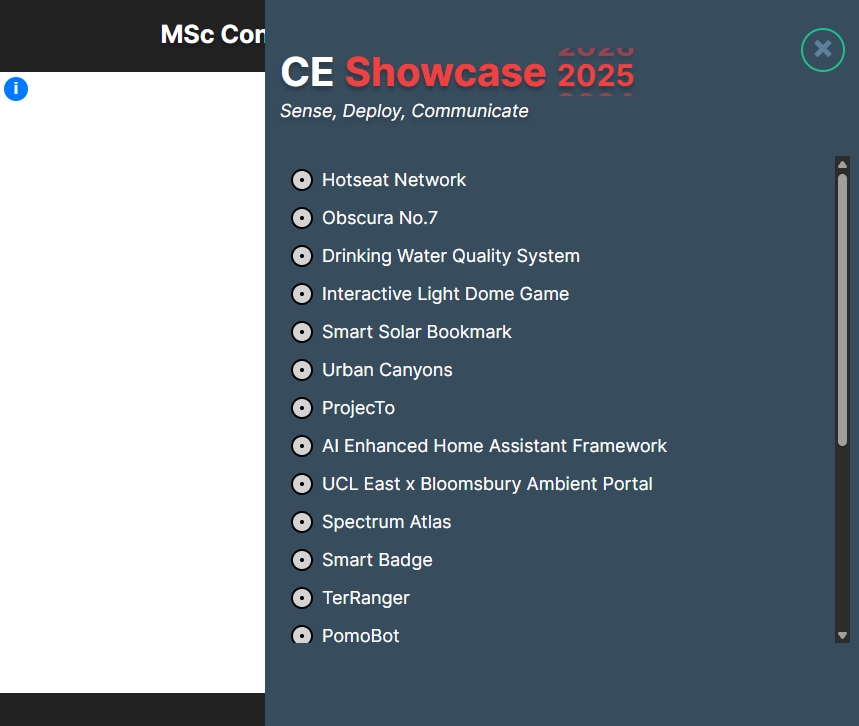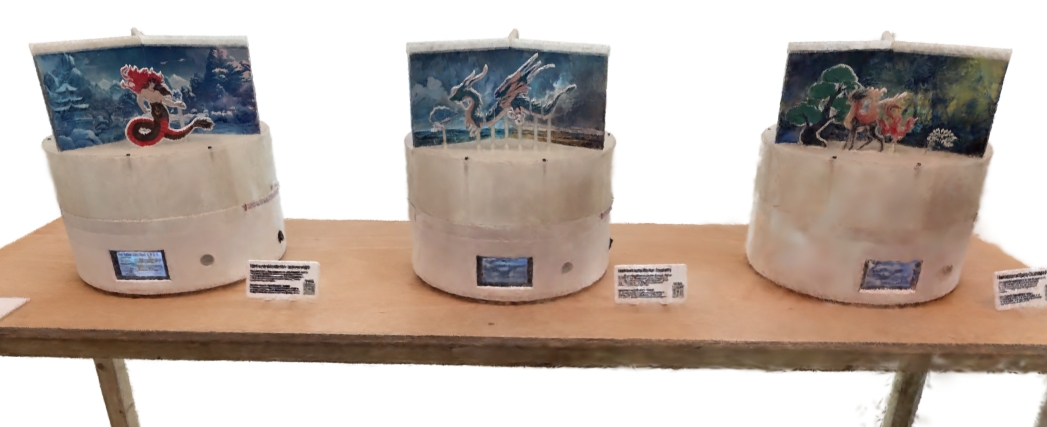Sense, Deploy, Communicate and Archive
Our annual exhibition of the MSc Connected Environments at UCL East took place from 17 July to 3 August 2025 at UCL Marshgate, showcasing the final projects of students graduating from the programme. The exhibition explored how digital technologies can be used to interpret and improve interactions with our built and natural environments. If you missed it, we have you covered.
Throughout the year, students worked in and around Queen Elizabeth Olympic Park and the UCL East Campus, using them as living lab for concept development and live deployment of sensing systems and digital platforms. The exhibition highlighted a wide range of responses to the challenge to sense, deploy, and communicate data from environmental sensing to data-driven approaches for shaping urban experiences.
At the close of each exhibition, two key questions arise:
- How can we ensure future students, and those who could not attend, can still experience and be inspired by the projects developed by the Connected Environments cohort?
- How do we address the issue of space, storage, and sustainability within the programme?
Both challenges are not unique to Connected Environments, they are shared by many academic programmes and also by the wider GLAM sector (Galleries, Libraries, Archives, and Museums). Across these fields, institutions are working to find better ways to preserve, digitise, and share the work they produce. This includes making sure digital content is easy to access, well-organised, and stored in ways that can last over time. A complex mix of issues, from digital literacy gaps and infrastructure limitations to the need for shared definitions and strategies for digital agenda, making digital preservation and reuse not just a technical issue but a strategic need.
Accessibility and preservation are just one part of the challenge. Space is always at a premium, and year after year, module by module, the physical devices of student projects fills the available space in our lab. This limits not only how long devices can be displayed, but also how visible and usable they remain over time. Most of the devices are built as prototypes, designed for short-term experimentation rather than long-term use. Unfortunately, this means that some of them eventually have to be let go, though not without careful thought around sustainability. In line with our ethos of reuse and recycle, many of the devices left behind are disassembled and repurposed for future use. This approach helps reduce waste and supports a culture of continuity, experimentation, and shared learning across current and future students.
For these reasons, we start to explore a practical solution to improve accessibility and support long-term archiving within the Connected Environments programme since 2023, a practice we hope can be expanded and shared with colleagues across other programme and institutions. We have continued to develop the Connected Environments Digital Showroom, now updated with the 2024-2025 cohort’s dissertations and final works.

This web-based platform serves as a growing memory of the programme and a resource for future students, researchers, and collaborators. Among the various techniques explored for capturing student-built devices, we adopted a method that balances speed, photographic quality, and low storage impact, essential for delivering results on the web and achieving the level of accessibility we aimed for. We built a custom web tool using open JavaScript frameworks (e.g. Three.js) and Gaussian Splatting, a technique for rendering 3D scenes from multi-view images. Using mobile apps like Scaniverse, we digitally captured the spatial and material qualities of each device with high fidelity, creating immersive records that can be accessed, revisited, and referenced by future cohorts.
We believe the Connected Environments Digital Showroom is more than a gallery, it is a living archive, a pedagogical tool, and a foundation for reflecting on sustainability, accessibility, and collaborative design. Please let us know what you think and any feedback on it.
The platform has been developed by Dr Valerio Signorelli. Special thanks to Prof Steven Gray for his contributions to scanning the last Connected Environments cohort and infrastructure hosting.
- Explore the digital showroom: CE Digital Showroom
- Learn more about the programme: MSc Connected Environments
